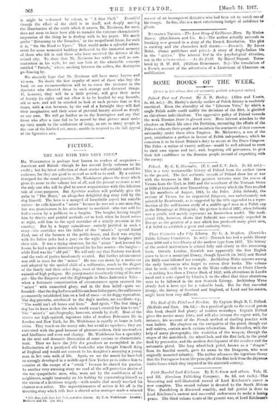MODERN WAR PAINTINGS.•
WE congratulate Mr. Nevinson most heartily on the fascinating book which forms the subject of this notice. Unfortunately, nothing is more difficult than to review a book of pictures. As Ralegh, or the Pseudo-Ralegh, said long ago :-
" Tho tongue may tell what the eye discovers ; Joys unseen are never sung."
We cannot give our readers the joy of the wonderful frontispiece, which shows under the blue sky of early morning a French battalion marching along a pave road, " their heads all bending, and their points all of a row." As one gazes one almost hears the thunder of their tread and shares the splendid impulse which sends them forward. Mr. Ncvinson is a Cubist, though, as we understand from the essay introducing him, a Cubist who wears his cubes with a difference. For ourselves, we should not care if he were ten times more the child of the T-square than lie is so long ash) can produce pictures like those we are criticizing. It is, we fear, very old-fashioned to consider a picture on its mere merits, upon the im- pression it makes, and to ask whether it pleases rather than whether it improves the mind or conforms to some bespectacled gentleman's theory of what the arts ought to do—elongate ore's finger-tips, or make one's toes tingle, or give one a sense of expansion, mental and physical, like Leech's schoolboy. (" Lor ! Ma, I fool just as if my jacket was but- toned ! ") Anyway, we, who arc well contented if we can enjoy the things that others understand, have found in Mr. Nevinson's pictures glory and delight. Take " The Mitrailleuse," grim and square. At first sight it may seem ugly, if powerful ; but we venture to say that this and the "Motor Ambulance Driver " drawing have only to be looked at a few times to render up the secret of beauty. " Searchlights," a pageant of the heavens, could be enjoyed by a Rural Dean without scandal. We suggest it in all cariousness as offering grcao possibilities for a wall-paper of the future. Worked in long strips, and perhaps with a few modifications, and provided that the colours were well arranged, it ought to prove very attractive, as also should " Pursuing a Taube " and the glorious picture " Before the Storm." That., however, though suitable for a wall-paper, would be better as a big mural decoration. " The Doctor " is attractive from it force and cunning, but we expect it will give rather too much thrill to the ordinary reader. The same must be said of the powerful " In the Observation Ward." Splendid with its reminiscence of some of the noblest moods of Jean Francois Millet is "Twilight." The "Flooded Trench on the Yser " is also a good example of Mr. Nevinson's landscape at; le. What is less successful, though
• Modern' War Paintings. By C. B. W. Nevin:son. London: Grant Richards. 1103. ed. Intl
it might be is demucel by colour, is "A Star Shell." Beautiful though the effect of the shell is in itself, and deeply moving the illumination of the earth which it causes, Mr. Novhison, for once, does not seem to have been able to transfer the extreme characteristic impression of the thing lie is dealing with to his paper. We much prefer "Returning to the Trenches," or the magnificent frieze, for such it is, " On the Road to Ypres." That would make a splendid adorn- inent for some memorial building dedicated to the immortal memory of those who fell in and those who have survived the defence of the ruined city. To show that Mr. Nevinson has width as well as con- centration in his style, let any one. look at the admirable seascape entitled " Patrols," where, smoking between the rollers, the destroyers go dancing by.
We sincerely hope that Mr. Nevinson will have many buyers and viewers. No doubt the first impulse of most of those who buy the book on our recommendation will be to curse the reviewer in the Spectator who directed them to such strange and distorted things. lf, however, they will be a little patient, will give their sense of. beauty its rights and not allow it to be hustled by any formula, old or new, and will be satisfied to look at each picture four or five times, with a rest between, by the end of a fortnight they wilt find their imagination and their sense of pictorial beauty stlired as deeply as our own. We will go further as. to the frontispiece and say that those who after a time fail to be moved by that picture must make up their minds to the misfortune of being, as are so many people in the ease of the kindred sat, music, unable to respond to the full appeal of the figurative arts.



























 Previous page
Previous page